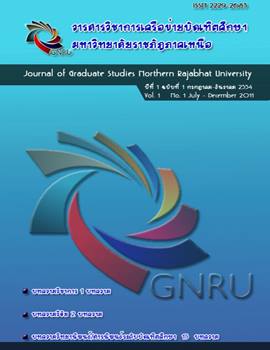การจัดการระบบสารสนเทศในโรงเรียนอาชีวศึกษาเอกชนจังหวัดลำปาง
Main Article Content
Abstract
บทคัดย่อ
การวิจัยนี้มีวัตถุประสงค์เพื่อศึกษาสภาพการจัดการระบบสารสนเทศในโรงเรียนอาชีวศึกษา เอกชนจังหวัดลำปาง กลุ่มตัวอย่างที่ใช้ในการวิจัย คือ กรรมการบริหารโรงเรียน ครูผู้สอน บุคลากร สนับสนุนการสอน และผู้รับผิดชอบการจัดการระบบสารสนเทศ จำนวน 278 คน เครื่องมือที่ใช้ในการ วิจัยเป็น แบบสอบถามแบบมาตราส่วนประมาณค่าและแบบปลายเปิด สถิติที่ใช้ในการวิจัย คือค่าร้อยละ ค่าเฉลี่ย ส่วนเบี่ยงเบนมาตรฐานและความถี่
ผลการวิจัยพบว่า สภาพการจัดการระบบสารสนเทศในโรงเรยนอาชีวศึกษาเอกชนจังหวัดลำปาง ทั้งโดยรวมและรายขั้นมีการปฏิบัติอยู่ในระดับมาก เรยงลำดับตามค่าเฉลี่ยของการปฏิบัติจากมากไปน้อย คือ ขั้นการนำข้อมูลไปใช้รองลงมาคือ ขั้นการวิเคราะห์ข้อมูล ขั้นการจัดหน่วยหรือคลังข้อมูล ขั้นการตรวจสอบข้อมูล ขั้นการประมวลผลข้อมูล และขั้นการเก็บรวบรวมข้อมูล
ส่วนปัญหาที่พบคือ การเก็บรวบรวมข้อมูลใช้เวลานานและมีความซํ้าซ้อน การตรวจสอบ ข้อมูลทำไม่ทันตามกำหนดระยะเวลา การประมวลผลข้อมูลไม่เป็นปัจจุบันและไม่ครอบคลุม การจัดคลังข้อมูลไม่เป็นหมวดหมู่ สืบค้นข้อมูลได้ยาก ใช้สถิติในการวิเคราะห์ข้อมูลไม่เหมาะสม การนำข้อมูล ไปใช้ไม่ตรงประเด็น ไม่สมบูรณ์ และผู้บริหารไม่นำข้อมูลสารสนเทศไปใช้ประกอบการตัดสินใจในการบริหาร
Abstract
The purpose of this research was to study the state of the information system management in the private vocational schools in Lampang province. The sample group consisted of 278 people and included school board members, teachers, training personnel, and information system personnel. This group was given a rating-scale and open-ended questionnaire.
The results were:
1. The information system management in the private vocational schools in Lampang province, as a whole and by individual aspect, was rated at a high level of functionality. In order of most to least importance, the key aspects of information system management were reported to be data usage, data analysis, data organization and storage, data accuracy, data processing, and data collection.
2. Problems with the information system management were reported to be: data collection was time consuming; there was an overlap in collected data or redundancy in data collection; data collection did not adhere to scheduled times; data processing was not up to date or live; lack of organization in data; statistics and data for analysis were incorrect or inapplicable to the task; administrators sometimes ignored the data in their decision making process.


